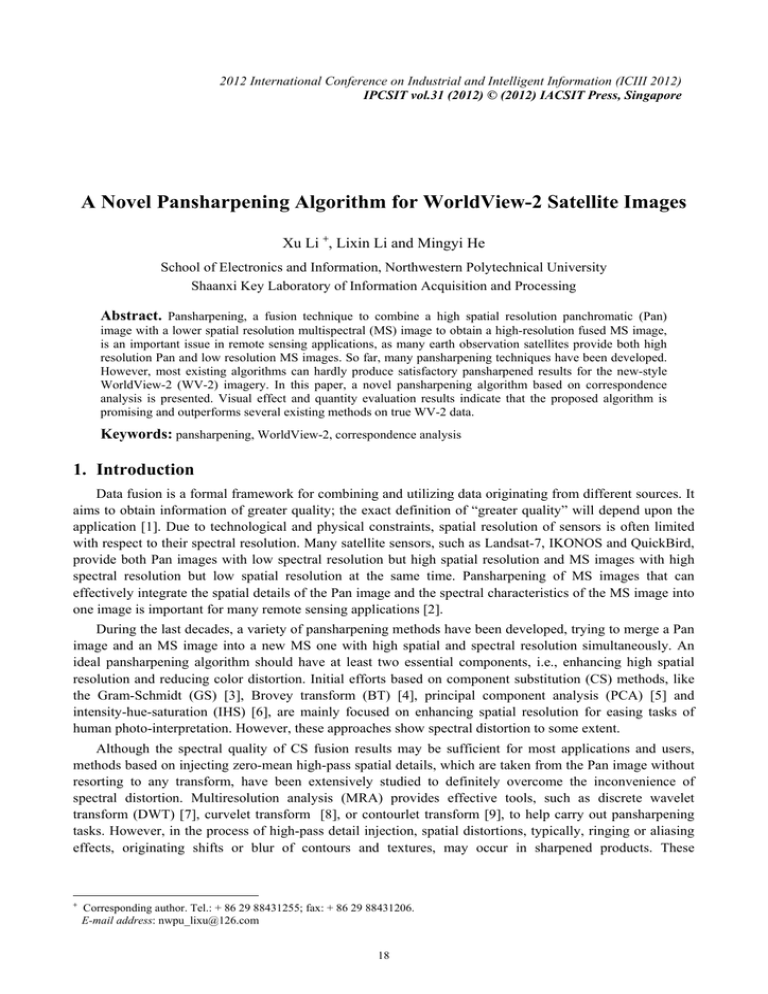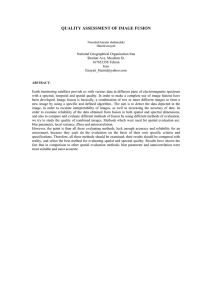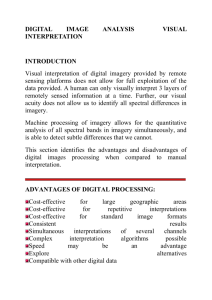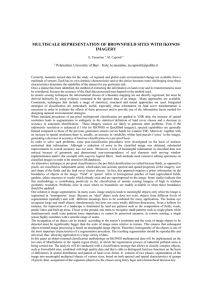A Novel Pansharpening Algorithm for WorldView-2 Satellite Images Xu Li
advertisement

2012 International Conference on Industrial and Intelligent Information (ICIII 2012) IPCSIT vol.31 (2012) © (2012) IACSIT Press, Singapore A Novel Pansharpening Algorithm for WorldView-2 Satellite Images Xu Li +, Lixin Li and Mingyi He School of Electronics and Information, Northwestern Polytechnical University Shaanxi Key Laboratory of Information Acquisition and Processing Abstract. Pansharpening, a fusion technique to combine a high spatial resolution panchromatic (Pan) image with a lower spatial resolution multispectral (MS) image to obtain a high-resolution fused MS image, is an important issue in remote sensing applications, as many earth observation satellites provide both high resolution Pan and low resolution MS images. So far, many pansharpening techniques have been developed. However, most existing algorithms can hardly produce satisfactory pansharpened results for the new-style WorldView-2 (WV-2) imagery. In this paper, a novel pansharpening algorithm based on correspondence analysis is presented. Visual effect and quantity evaluation results indicate that the proposed algorithm is promising and outperforms several existing methods on true WV-2 data. Keywords: pansharpening, WorldView-2, correspondence analysis 1. Introduction Data fusion is a formal framework for combining and utilizing data originating from different sources. It aims to obtain information of greater quality; the exact definition of “greater quality” will depend upon the application [1]. Due to technological and physical constraints, spatial resolution of sensors is often limited with respect to their spectral resolution. Many satellite sensors, such as Landsat-7, IKONOS and QuickBird, provide both Pan images with low spectral resolution but high spatial resolution and MS images with high spectral resolution but low spatial resolution at the same time. Pansharpening of MS images that can effectively integrate the spatial details of the Pan image and the spectral characteristics of the MS image into one image is important for many remote sensing applications [2]. During the last decades, a variety of pansharpening methods have been developed, trying to merge a Pan image and an MS image into a new MS one with high spatial and spectral resolution simultaneously. An ideal pansharpening algorithm should have at least two essential components, i.e., enhancing high spatial resolution and reducing color distortion. Initial efforts based on component substitution (CS) methods, like the Gram-Schmidt (GS) [3], Brovey transform (BT) [4], principal component analysis (PCA) [5] and intensity-hue-saturation (IHS) [6], are mainly focused on enhancing spatial resolution for easing tasks of human photo-interpretation. However, these approaches show spectral distortion to some extent. Although the spectral quality of CS fusion results may be sufficient for most applications and users, methods based on injecting zero-mean high-pass spatial details, which are taken from the Pan image without resorting to any transform, have been extensively studied to definitely overcome the inconvenience of spectral distortion. Multiresolution analysis (MRA) provides effective tools, such as discrete wavelet transform (DWT) [7], curvelet transform [8], or contourlet transform [9], to help carry out pansharpening tasks. However, in the process of high-pass detail injection, spatial distortions, typically, ringing or aliasing effects, originating shifts or blur of contours and textures, may occur in sharpened products. These + Corresponding author. Tel.: + 86 29 88431255; fax: + 86 29 88431206. E-mail address: nwpu_lixu@126.com 18 impairments, which may be as much annoying as spectral distortions, are emphasized by mis-registration between Pan and MS data, particularly if the MRA underlying detail injection is not shift-invariant. The WV-2 satellite, launched in Oct. 2009, is the first commercial satellite to carry a very high spatial resolution sensor with one Pan and eight MS bands. The MS bands (Band1=Coastal, Band2=Blue, Band3=Green, Band4=Yellow, Band5=Red, Band6=Red Edge, Band7=Near-Infrared1, Band8=NearInfrared2) cover the spectral range from 400nm-1050nm at a spatial resolution of 1.84m, while the Pan band covers the spectrum from 450nm-800nm with 4x greater spatial resolution, 0.46m. With the availability of the WV-2 imagery, more and more challenges are brought to the pansharpening research. There are few effective pansharpening methods for the new-style WV-2 data. Although Padwick et al. [10] developed an HCS approach for sharpening WV-2 imagery recently, which sharpened all eight bands at a time, the sharpened MS bands produced acceptable visual results. A new pansharpening algorithm designed for WV-2 imagery based on the correspondence analysis procedure to inject the spatial details of Pan image into all MS bands is proposed in this paper. To verify the efficiency of the algorithm, experimental evaluations are carried out on true WV-2 data. 2. The Proposed Pansharpening Algorithm 2.1. Correspondence analysis Correspondence analysis (CA) is a multivariate technique, which was originally introduced for analyzing contingency tables. It can be applied to data tables other than contingency tables as long as the elements of a table to be analyzed by CA are dimensionally homogeneous (e.g., same physical units, so that they can be added) and non-negative (so that they can be transformed into probabilities or proportions). Compared to the PCA method which can be applied best if the data are Gaussian and grouped into a single cluster and also depends on the extent of multicollinearity within the data to be analyzed, CA is applied to remote sensing data to fuse Pan data with MS data in order to preserve integrity of the original data to large extent and therefore improve the quality of the final fused image [11]. In the CA approach, the data table X is transformed into a table of contributions to the Person chi-square statistics. Fist, pixel xij values are converted to proportions pij by dividing each pixel xij value by the sum x+ + of all the pixels in data set. The result is a new data set of proportions Q and the size is (row×column). Row weight pi + is equal to xi + x+ + , where xi + is the sum of values in row i. Vector [ pi + ] is size [ ] of row. Column weight p+ j is equal to x+ j x+ + , where x+ j is the sum of values in column j. Vector p+ j is size of column. The Pearson chi-square statistic χ 2p is a sum of squared χ ij values, computed for every cell ij of the contingency table. ⎡p − p p ⎤ ij i+ + j ⎥ pi + p+ j ⎥⎦ ⎢⎣ χ ij = x+ + ⎢ (2) If we use qij values instead of χ ij values, so that qij = χ ij x++ , eigenvalues will be smaller than or equal to 1. We use the qij values to form the matrix Qrow×column , which is ⎡p − p p ⎤ ij i+ + j ⎥ Qrow×column = qij = ⎢ ⎢ pi + p+ j ⎥ ⎣ ⎦ [ ] (3) The matrix of eigenvector is given by T U column×column = Qcolumn ×row Qrow×column (4) MS data are then transformed into the component space using the matrix of eigenvectors. Although the PCA and CA methods are very similar to each other in terms of structure, the CA method differs from PCA in two distinct ways: First, CA preserves the chi-square distance when computing the 19 association between spectral values in various bands. Second, fusion takes place in the last component as opposed to the first component in PCA. 2.2. A novel pansharpening algorithm based on CA The proposed CA-based pansharpening algorithm can accept any number of input bands and thus is an ideal candidate for sharpening WV-2 8-band MS imagery. As shown in Fig.1, the detailed steps of this new algorithm are: (1) Transform the 8-band MS imagery ( Band1 , Band 2 ,..., Band8 ) into CA component space (forward CA transform); (2) Match the Pan image with the last CA component and obtain a new Pan image; First, letting I 2 = (C L ) 2 (5) P 2 = (Pan ) 2 (6) in which C L represents the last CA component. Let the mean and standard deviation of I 2 be denoted by μ I and σ I , and let the mean and standard deviation of P 2 be denoted by μ P and σ P . Next, match the P 2 signal to the I 2 signal using the following equation: 2 Pnew = ( ) σI 2 P − μP + σ P + μI − σ I σP (7) 2 as follows: Finally, the new Pan image, denoted by Pnew is constructed by taking square root of the Pnew 2 Pnew = Pnew (8) (3) Substitute the last CA component with the new Pan image; Transform the new data set back into the original data space (inverse CA transform) to produce the sharpened MS images. Fig. 1: Pansharpening scheme 3. Experimental Results The testing images consist of a WV-2 data set with a 0.5m spatial resolution Pan image and 8-band 2.0m spatial resolution MS imagery and were taken in Dec. 2009, which cover the urban area of Rome, Italy. The experimental areas constitute cars, trees, buildings, and roads. Before the sharpening, the MS images were coregistered to the corresponding Pan image and were resampled to the same pixel size as the Pan image by using bi-cubic interpolation. The propose algorithm is compared with the HCS method and IAWP method [12]. 3.1. Visual Analysis The visual performances of the WV-2 imagery are shown in Fig.2 for an RGB (Band 5-3-2) composition of 800 by 800 pixels. In Fig.2 (c), HCS method produces slight color distortions, especially on the roofs of the buildings. From Fig.2 (d), it can be found that the IAWP method loses much spatial details, while the spectral information is kept well. The sharpened image with the new algorithm shows the best visual effect and provides high spatial quality, as well as the maximum resemblance to natural color. 20 (a) (b) (c) (d) (e) Fig. 2: Comparison of different sharpened results as an RGB (Band 5-3-2) combination. (a) True color MS image. (b) Pan image. (c) HCS method. (d) IAWP method. (e) The proposed method. 21 3.2. Quantitative Analysis There are several objective evaluation indexes employed in this experiment including the correlation coefficient (CC, sCC), the spectral angle mapper (SAM), and the relative dimensionless global error in synthesis (ERGAS) [13, 14]. CC shows the similarity in small size structures between the fused and original pixels. The higher spatial correlation coefficients (sCC) between the fused filtered images and the Pan filtered image are, the more spatial information of the Pan image is incorporated during the fusion process. SAM has been widely used in MS or hyperspectral image analysis to measure the spectral similarity between substance signatures for material identification, which is usually averaged over the whole image to yield a global measurement of spectral distortion. ERGAS between the original and sharpened image shows the global spectral quality of the fused result. Quantitative assessments of the pansharpening algorithms are given in Table I. From the sCC index, it can be concluded that the spatial resolution enhancement of the proposed algorithm outperforms the other two methods. Although the SAM value of the proposed algorithm is a little higher than that of the IAWP, ERGAS values indicate that the proposed method has the best global spectral quality. As a general observation, it is seen that the proposed algorithm works well and gives a good trade-off between the spatial resolution enhancement and the spectral information preservation. Table I. Evaluation Results of Considered Methods with Real Pan and MS Images sCC CC SAM ERGAS (ideal value: 1) (ideal value: 1) (ideal value: 0) (ideal value: 0) R 0.896 0.967 G 0.896 0.964 0.649 5.97 B 0.889 0.959 R 0.856 0.991 G 0.856 0.991 0.492 5.63 B 0.849 0.989 R 0.915 0.979 G 0.913 0.978 0.543 5.54 B 0.910 0.976 Method HCS IAWP Proposed 4. Conclusions A novel pansharpening algorithm designed for WV-2 satellite images is proposed in this paper. It takes advantage of correspondence analysis and treats any number of input MS bands as a whole to sharpen, aiming at keeping the spectral information while simultaneously increasing the spatial resolution. The experimental results show that the proposed algorithm performs well on the WV-2 data which contain mixed areas. The results were then compared with those obtained from the recent two approaches. This comparison clearly shows that the new algorithm gives very good visual results and produces nondistorted image colors. Moreover, in terms of quantitative indexes, this approach provides a global appreciate sharpened quality. 5. Acknowledgements This work is partially supported by the National Natural Science Foundation of China (No.60736007), Aviation Science Foundation of China (No.2009ZD53047) and NPU Foundation for Fundamental Research (No.JC20110263). 6. References [1] L. Wald. Some terms of reference in data fusion. IEEE Transactions on Geoscience and Remote Sensing. 1999, 37(3): 1190-1193. [2] G. Camps-Valls, J. A. Benediktsson, L. Bruzzone, and J. Chanussot. Introduction to the issue on advances in 22 remote sensing image processing. IEEE Journal of Selected Topics in Signal Processing. 2011, 5(3): 365-369. [3] C. A. Laben, and B. V. Brower. Process for enhancing the spatial resolution of multispectral imagery using pansharpening. US Patent 6011875. Technical Report, Eastman Kodak Company, 2000. [4] J. G. Liu. Smoothing filter-based intensity modulation: A spectral preserve image fusion technique for improving spatial details. International Journal of Remote Sensing. 2000, 21(18): 3461-3472. [5] Z. Wang, D. Ziou, D. Li, and Q. Li. A comparative analysis of image fusion methods. IEEE Transactions on Geoscience and Remote Sensing. 2005, 43(6): 1391-1402. [6] T. Tu, S. Su, H. Shyu, and P. Huang. A new look at IHS-like image fusion methods. Information Fusion. 2001, 2(3): 177-186. [7] Y. Zhang. A new merging method and its spectral and spatial effects. International Journal of Remote Sensing. 1999, 20(10): 2003-2014. [8] M. Choi, R. Y. Kim, M. Nam, and H. O. Kim. Fusion of multispectral and panchromatic satellite images using the curvelet transform. IEEE Geoscience and Remote Sensing Letters. 2005, 2(2): 136-140. [9] A. G. Mahyari, and M. Yazdi. Panchromatic and multispectral image fusion based on maximization of both spectral and spatial similarities. IEEE Transactions on Geoscience and Remote Sensing. 2011, 49(6): 1976-1985. [10] C. Padwick, M. Deskevich, F. Pacifici, and S. Smallwood. WorldView-2 pan-sharpening. ASPRS 2010, San Diego, California. [11] H. I. Cakir. Development and assessment of advanced data fusion algorithm for remotely sensed data. Ph.D dissertation, North Carolina State University, Raleigh, 2003. [12] Y. Kim, C. Lee, D. Han, Y. Kim, and Y. Kim. Improved additive-wavelet image fusion. IEEE Geoscience and Remote Sensing Letters. 2011, 8(2): 263-267. [13] M. C. El-Mezouar, N. Taleb, K. Kpalma, and J. Ronsin. An IHS-based fusion for color distortion reduction and vegetation enhancement in IKONOS imagery. IEEE Transactions on Geoscience and Remote Sensing. 2011, 49(5): 1590-1602. [14] L. Alparone, L. Wald, J. Chanussot, C. Thomas, P. Gamba, and L. Mann Bruce. Comparison of pansharpening algorithms: Outcome of the 2006 GRS-S data-fusion contest. IEEE Transactions on Geoscience and Remote Sensing. 2007, 45(10): 3012-3021. 23






